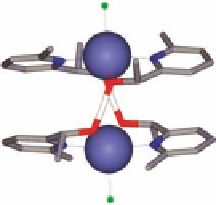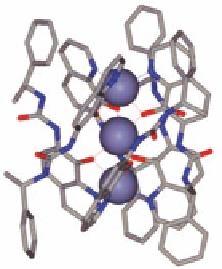Chemistry Reference
In-Depth Information
O
3Zn
2+
6
N
H
H
OH
(
S
)-
75
(
P
)-Zn
4
[(
S
)-
75
]
6
OH
2Co
2+
N
4
(
R
)-
76
(
P
)-Co
2
[(
R
)-
76
]
2
Cl
2
Figure 4.34 Hierarchical self-assembly of enantiomerically pure non-covalently assembled
helicates (P)-[Zn
3
(75)
6
] and (L,L)-[Co
2
{(R)-76}
4
] (X-ray crystal structure analyses, H atoms and
solvent molecules omitted).
4.7.10 Non-Covalently Assembled Ligand Strands
The last examples to be reported in this section are actually very interesting because these
cases use chiral ligand subunits
75
and
76
that have only one chelating metal binding site
(Figure 4.34).
Since these contain additional functional groups, however, that are capable of being
engaged in additional non-covalent interactions, like hydrogen bonds, they can organize
further to hierarchically assembled helicates with non-covalently assembled ligand
strands in a well defined matter. Examples for such systems have been reported by
M. Albrecht [74] and by S.G. Telfer and R. Kuroda [75].
4.8 Summary and Outlook
Over the last 30 years helicates have certainly been the most studied types of metallosu-
pramolecular aggregates. The wealth of information gathered in all these studies now pro-
vides us with a pretty good idea how to control certain structural aspects of these kinds of
supramolecular assemblies. We have learned for instance that self-sorting is a very com-
mon feature in helicate chemistry - no matter whether based on different numbers of
metal binding sites, different types of binding sites, or different distances between the





























Search WWH ::

Custom Search